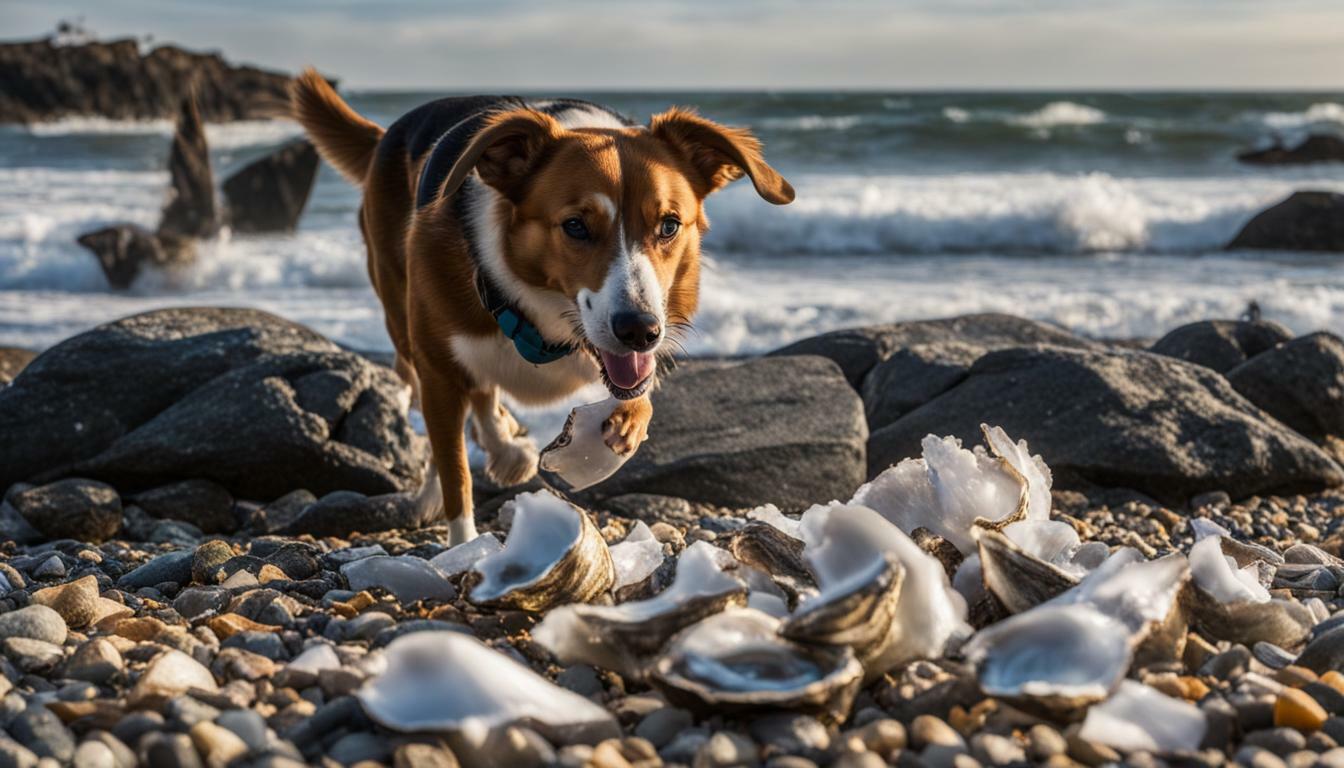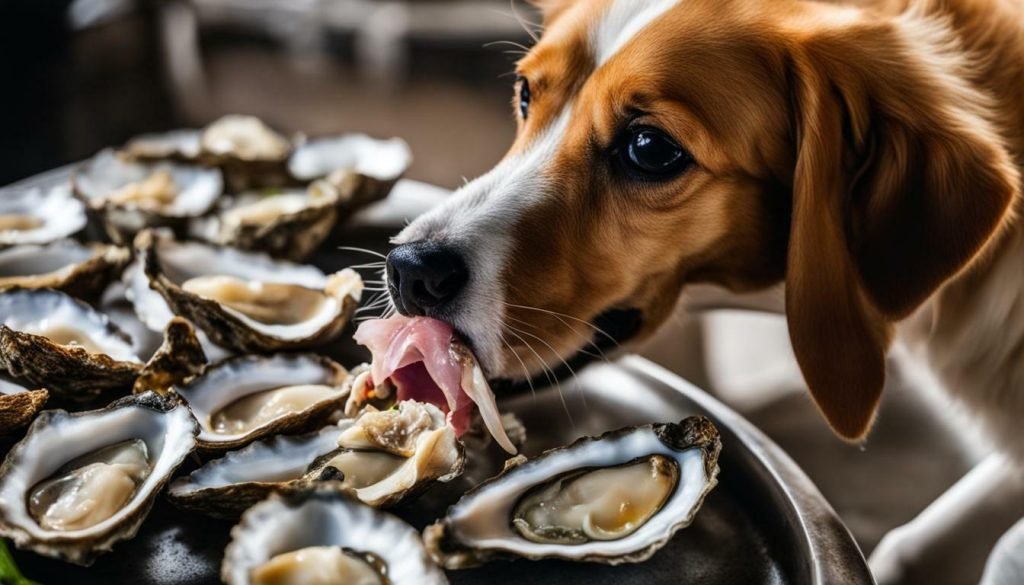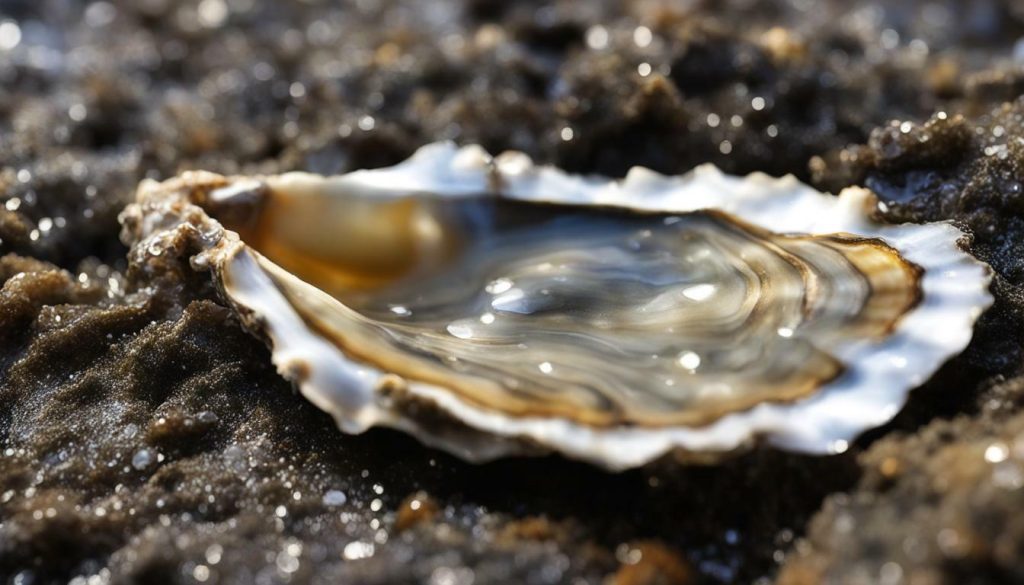
Many pet owners wonder if it is safe to include oysters in their dog’s diet. Let’s dive deep into this shellfish dilemma!
Factual data: Dogs can eat oysters, but there are some things to consider. Oysters are a good protein alternative for dogs with allergies and are rich in omega-3 fatty acids, zinc, selenium, and iron. However, oysters should be fed in moderation and cooked properly to avoid health risks. Raw oysters can contain harmful bacteria. Oysters can also absorb toxins, so choosing oysters that have undergone toxicity tests is important. Dogs may be allergic to oysters, so it’s best to introduce them slowly and monitor for any adverse reactions. It’s also crucial to remove the shells before feeding oysters to dogs. Overall, oysters can be a beneficial and tasty snack for dogs when prepared and fed safely.
Key Takeaways:
- Oysters can be included in a dog’s diet, but moderation is key.
- Cooking oysters properly is essential to avoid health risks.
- Choosing oysters that have undergone toxicity testing is important.
- Introduce oysters to your dog’s diet slowly and monitor for any allergic reactions.
- Always remove oyster shells before feeding them to your dog to prevent choking hazards.
The Nutritional Benefits of Oysters for Dogs
Oysters pack a nutritional punch, offering a range of benefits for our four-legged friends. These shellfish are not only a delicious treat but also provide essential nutrients that contribute to a healthy and balanced diet for dogs.
1. High in Protein: Oysters are rich in protein, which is essential for the growth, development, and repair of tissues in dogs. Protein is necessary for maintaining healthy muscles, bones, skin, and hair.
2. Omega-3 Fatty Acids: Oysters are a great source of omega-3 fatty acids, including EPA and DHA. These fatty acids have anti-inflammatory properties and support the immune system, joint health, and cognitive function in dogs.
3. Rich in Minerals: Oysters are packed with minerals such as zinc, selenium, and iron. Zinc plays a crucial role in skin and coat health, immune function, and wound healing. Selenium acts as an antioxidant and supports thyroid function, while iron is essential for red blood cell production and oxygen transport.

When feeding oysters to your dog, it is important to keep a few things in mind. Firstly, oysters should be cooked thoroughly to eliminate the risk of harmful bacteria. Raw oysters may contain bacteria that can cause digestive upset or other health issues in dogs.
Additionally, oysters can absorb toxins from their environment, so it is crucial to choose oysters that have undergone toxicity testing. This ensures that the oysters are safe for your dog to consume without any potential adverse effects.
In conclusion, oysters can be a valuable addition to your dog’s diet, providing them with essential nutrients and health benefits. However, it is vital to feed oysters in moderation, cook them properly, and choose safe oysters that have undergone toxicity testing. By following these guidelines, you can safely introduce this nutritious seafood to your canine companion’s diet.
Risks of Feeding Oysters to Dogs
While oysters can be beneficial, it’s crucial to be aware of the potential risks involved in including them in your dog’s diet. One of the main concerns is the possibility of allergies. Dogs, just like humans, can develop allergies to certain foods, and oysters are no exception. If your dog has never had oysters before, it’s important to introduce them slowly and keep a close eye on any adverse reactions. Symptoms of an allergic reaction may include itching, hives, vomiting, or diarrhea.
Another risk to consider is the presence of harmful bacteria in raw oysters. Raw oysters can contain bacteria such as Vibrio vulnificus or Salmonella, which can lead to food poisoning in dogs. To avoid this, it is recommended to cook the oysters thoroughly before feeding them to your furry friend. Cooking the oysters will help eliminate any potential bacteria and make them safer for consumption.
Furthermore, oysters have the ability to absorb toxins from their environment, such as heavy metals or pollutants present in the water. Therefore, it is essential to choose oysters that have undergone toxicity tests to ensure they are safe for your dog to eat. Look for oysters that are sourced from clean waters and have been certified as safe for consumption.
Finally, it’s worth noting that oyster shells can pose a choking hazard or cause injuries to your dog’s digestive system. Always ensure the shells are fully removed before feeding oysters to your dog. This will help prevent any potential accidents and ensure the safety of your furry friend.
In summary, while oysters can provide nutritional benefits to dogs, it’s important to be mindful of the potential risks involved. Introduce oysters slowly, cook them thoroughly, choose safe sources, and remove the shells to ensure your dog can enjoy this tasty treat without any harm. By taking these precautions, you can safely incorporate oysters into your dog’s diet and provide them with a tasty and nutritious snack.
Risks of Feeding Oysters to Dogs – Summary:
– Allergies: Ensure to introduce oysters slowly and monitor your dog for any allergic reactions such as itching, hives, vomiting, or diarrhea.
– Bacterial Contamination: Avoid feeding raw oysters to your dog as they can contain harmful bacteria like Vibrio vulnificus or Salmonella. Cook the oysters thoroughly to eliminate any bacteria.
– Toxin Absorption: Choose oysters that have undergone toxicity tests to ensure they are safe for your dog. Oysters can absorb toxins from their environment, so it’s crucial to source them from clean waters.
– Choking Hazard: Always remove the shells before feeding oysters to your dog to prevent choking or injuries to their digestive system.
Considering these risks and taking the necessary precautions will help you safely include oysters in your dog’s diet and provide them with a healthy and enjoyable treat.
| Risks of Feeding Oysters to Dogs | Precautions |
|---|---|
| Allergies | Introduce oysters slowly and monitor for adverse reactions |
| Bacterial Contamination | Cook oysters thoroughly to eliminate bacteria |
| Toxin Absorption | Choose oysters from certified safe sources |
| Choking Hazard | Remove oyster shells before feeding |
Cooking Oysters for Canine Consumption
Properly preparing oysters before feeding them to your furry friend is essential to ensure their safety and enjoyment. While dogs can eat oysters, it’s important to follow some guidelines to minimize any potential health risks.
The first step is to cook the oysters thoroughly. Raw oysters may contain harmful bacteria that can cause digestive issues in dogs. By cooking the oysters, you eliminate this risk and make them safer for your canine companion. Steaming or boiling the oysters until the shells open is an easy and effective cooking method.
After the oysters are cooked, it’s crucial to remove the shells before serving them to your dog. Oyster shells can be sharp and may pose a choking hazard or cause internal injuries if swallowed. Taking the time to carefully remove the shells will help prevent any accidents and ensure your dog can enjoy the oysters without any issues.
| Preparation Steps: | Benefits: |
|---|---|
| 1. Cook oysters by steaming or boiling until shells open. | – A safe protein alternative for dogs with allergies. – Rich in omega-3 fatty acids, zinc, selenium, and iron. – Provides essential nutrients for overall health. |
| 2. Carefully remove the oyster shells before feeding them to your dog. | – Prevents choking hazards and potential internal injuries. – Ensures safe and enjoyable consumption for your dog. |

“Properly preparing oysters before feeding them to your furry friend is essential to ensure their safety and enjoyment.”
Feeding Oysters to Dogs – Dos and Don’ts
- Do cook the oysters thoroughly to eliminate the risk of harmful bacteria.
- Do remove the shells to prevent choking hazards and injuries.
- Do introduce oysters to your dog’s diet slowly and monitor for any adverse reactions.
- Don’t feed your dog raw oysters due to the potential health risks.
- Don’t forget to choose oysters that have undergone toxicity tests to ensure they are safe for consumption.
By following these preparation steps and guidelines for feeding oysters to your dog, you can offer them a nutritious and delicious treat while keeping their health and safety in mind.
Raw Oysters vs. Cooked Oysters for Dogs
The debate between raw and cooked oysters for dogs is important to consider when adding this delicacy to their diet. While raw oysters may seem more natural, they pose certain risks to your furry friend’s health. Raw oysters can harbor harmful bacteria, such as Vibrio vulnificus or Salmonella, which can cause digestive upset, diarrhea, and even serious infections in dogs.
Cooking oysters can help eliminate these risks by killing any bacteria present. Steaming or boiling oysters until the shells open is a recommended cooking method. This ensures that the oysters are fully cooked and safe for your dog to consume. It’s important to let the oysters cool before serving them to your pup, as hot oysters may cause burns or discomfort.
Additionally, cooking oysters allows the nutrients within them to become more easily digestible for your dog. Heat helps break down proteins and makes them more bioavailable, ensuring that your dog can absorb all the beneficial vitamins and minerals present in oysters. These include omega-3 fatty acids, which have anti-inflammatory properties, and minerals like zinc, selenium, and iron, which are essential for your dog’s overall health.
| Raw Oysters | Cooked Oysters |
|---|---|
| Potential bacterial contamination | Bacteria-killing cooking process |
| Harder to digest | Easier to digest and absorb nutrients |
| Risk of allergic reactions | Potential reduction in allergenicity |
Feeding your dog cooked oysters is a safer option, as it reduces the risk of bacterial contamination and helps improve nutrient absorption. Remember to introduce oysters gradually into your dog’s diet and monitor for any adverse reactions. It’s always best to consult with your veterinarian before making any changes to your dog’s diet or introducing new foods.
Table: Raw Oysters vs. Cooked Oysters for Dogs
- Raw Oysters
- Potential bacterial contamination
- Harder to digest
- Risk of allergic reactions
- Cooked Oysters
- Bacteria-killing cooking process
- Easier to digest and absorb nutrients
- Potential reduction in allergenicity
When it comes to incorporating oysters into your dog’s diet, cooked oysters offer a safer and more nutritious option. By following proper cooking methods and guidelines, you can provide your furry friend with a tasty and beneficial snack while minimizing potential health risks. Remember, moderation is key, and always prioritize your dog’s well-being when introducing new foods.

Ensuring the oysters you feed your dog are safe and free from toxins is crucial for their well-being. Oysters have the potential to absorb harmful substances from their environment, such as bacteria and toxins. Therefore, it’s important to select oysters that have undergone toxicity testing and come from reputable sources.
To determine if oysters are safe for your dog to consume, consider the following:
- Choose oysters from trusted suppliers who follow proper handling and testing procedures.
- Look for oysters that have been commercially harvested and have undergone quality control measures.
- Check for any certifications or approvals from food safety organizations.
Feeding your dog safe oysters can help prevent any potential health issues and ensure they receive all the nutritional benefits without the risks. Remember, it’s always best to consult with your veterinarian before introducing any new food into your dog’s diet, especially if they have any pre-existing conditions or allergies.

| Toxin | Safe Level (ppm) |
|---|---|
| Vibrio vulnificus | <30 |
| Heavy Metals (Mercury, Lead) | <0.5 |
| Paralytic Shellfish Poisoning (PSP) | <80 |
| Amnesic Shellfish Poisoning (ASP) | <20 |
Quote: “Feeding your dog safe oysters can provide them with essential nutrients while minimizing the risks associated with consumption.” – Dr. Jennifer Smith, Veterinarian
Introducing Oysters to Your Dog’s Diet
Introducing oysters to your dog’s diet requires a gradual approach to ensure their digestive system can handle this new addition. While oysters can provide numerous health benefits for dogs, it’s important to introduce them slowly and monitor for any adverse reactions. Here are some tips to help you incorporate oysters into your dog’s meals:
- Start small: Begin by offering your dog a small piece of cooked oyster as a treat. Watch for any signs of allergies or digestive upset, such as itching, vomiting, or diarrhea. If your dog tolerates it well, you can gradually increase the amount over time.
- Monitor for adverse reactions: As with any new food, it’s essential to monitor your dog for any adverse reactions when introducing oysters. Keep an eye out for any signs of allergies, such as hives, swelling, or difficulty breathing. If you notice any unusual symptoms, discontinue feeding oysters and consult your veterinarian.
- Cooking methods: It’s crucial to properly cook oysters before feeding them to your dog. Cooked oysters are safer for dogs as they reduce the risk of harmful bacteria and parasites. You can steam, boil, or grill oysters without adding any seasoning or oil. Avoid using butter or garlic, as these can be harmful to dogs.
Remember, moderation is key when feeding oysters to dogs. While oysters can be beneficial for their nutritional value, they should not replace your dog’s regular balanced diet. Consult your veterinarian to determine the appropriate amount of oysters based on your dog’s size, breed, and overall health. By following these guidelines, you can safely introduce oysters to your dog’s diet and provide them with a tasty and nutritious treat.

Incorporate oysters into your dog’s diet gradually to ensure their digestive system can handle this new addition. Monitor for any adverse reactions and cook the oysters properly before feeding them to your furry friend. Remember, moderation is key to maintain a balanced diet. Enjoy exploring the benefits of oysters for your dog while keeping their safety in mind!
| Benefits of Introducing Oysters to Your Dog’s Diet | Considerations when Feeding Oysters to Dogs |
|---|---|
| Rich in omega-3 fatty acids, zinc, selenium, and iron | Potential risks of allergies and digestive upset |
| Protein alternative for dogs with allergies | Importance of cooking oysters to prevent harmful bacteria |
| Nutritional boost for overall health and wellbeing | Choosing safe oysters that have undergone toxicity testing |
Allergic Reactions to Oysters in Dogs
Just like humans, dogs can develop allergies, and oysters may be a potential allergen that pet owners should be aware of. While oysters are generally safe for dogs to eat, it’s important to understand the risks and signs of allergic reactions.
Common symptoms of an allergic reaction in dogs include itching, redness, swelling, hives, vomiting, diarrhea, and difficulty breathing. If you notice any of these signs after feeding your dog oysters, it’s crucial to seek veterinary attention immediately. Allergic reactions can be severe and even life-threatening if not treated promptly.
To minimize the risk of allergic reactions, it’s recommended to introduce oysters to your dog’s diet gradually. Start with small amounts and monitor your dog closely for any adverse effects. If your dog has a known allergy to shellfish or seafood, it’s best to avoid feeding them oysters altogether.
| Allergy Symptoms | What to do |
|---|---|
| Itching, redness, swelling | Seek veterinary attention immediately |
| Vomiting, diarrhea | Monitor your dog closely and contact your vet if symptoms persist |
| Difficulty breathing | Emergency veterinary care is required |
Remember, moderation is key when feeding oysters to dogs. While they can provide nutritional benefits, excessive consumption can lead to digestive upset or other health issues. Always consult with your veterinarian before introducing any new food to your dog’s diet, especially if they have a history of allergies or sensitivities.

Before serving oysters to your dog, it’s vital to remove the shells to eliminate any potential risks. The shells can pose a choking hazard or cause injury to your furry friend’s digestive tract. Ensuring that your dog only consumes the soft, edible parts of the oysters will help prevent any mishaps.
To remove the shells, start by using a sturdy pair of kitchen gloves to protect your hands. Place the oyster on a flat surface and hold it firmly. Use a sharp knife to carefully pry open the shell. Take caution to avoid slipping and causing any accidents. Once the shell is open, gently slide the knife underneath the oyster to separate it from the shell. Be thorough in removing any small fragments or sharp pieces that may have broken off during the process.
Remember, oysters are a treat and should not make up a significant portion of your dog’s diet. Moderation is key to ensuring a balanced and nutritious meal plan for your canine companion. Always consult with your veterinarian before introducing oysters or any new food into your dog’s diet, especially if your dog has any underlying health conditions or dietary restrictions.
| Benefits of Removing Shells for Dogs | Considerations |
|---|---|
|
|
By taking the necessary precautions and removing the shells, you can safely incorporate oysters into your dog’s diet. Remember to prioritize your dog’s safety and well-being above all else. With the right preparation and feeding practices, oysters can be a delicious and nutritious addition to your furry friend’s meals.

While oysters offer numerous benefits, they should be given to dogs in moderation to ensure their overall well-being. Oysters are a great source of protein and are packed with essential nutrients like omega-3 fatty acids, zinc, selenium, and iron. These nutrients play a crucial role in maintaining a healthy immune system, promoting a shiny coat, and supporting overall growth and development in dogs. However, it’s important to remember that too much of a good thing can have negative consequences.
Feeding oysters to dogs should be approached with caution. Raw oysters, in particular, pose a risk of bacterial contamination and can cause gastrointestinal upset in dogs. It is highly recommended to cook oysters thoroughly before offering them to your furry friend. Cooking not only eliminates harmful bacteria but also makes the oysters more digestible for dogs. By steaming, boiling, or grilling oysters, you can ensure that they are safe and nutritious for your canine companion.
Another important consideration is the potential for allergic reactions. While allergies to oysters are uncommon in dogs, it’s always wise to introduce new foods slowly and monitor for any adverse reactions. Start by offering a small piece of cooked oyster and observe your dog’s response. If there are no signs of allergies, such as itching, redness, or digestive issues, you can gradually increase the amount over time. However, if any negative reactions occur, it’s best to avoid feeding oysters altogether.
| Benefits of Feeding Oysters to Dogs | Risks of Feeding Oysters to Dogs |
|---|---|
|
|
Remember, when feeding oysters to your dog, it’s crucial to remove the shells. Oyster shells can be a choking hazard and may cause injuries to your dog’s mouth or digestive tract. Always ensure that the oysters you choose have undergone toxicity testing to minimize the risk of exposure to harmful substances.
In conclusion, while oysters can be a beneficial and tasty snack for dogs, they should be given in moderation and cooked properly to avoid health risks. Introduce oysters slowly to assess any potential allergic reactions, and always remove the shells before feeding. By following these guidelines, you can provide your furry friend with a safe and nutritious treat.

“Feeding oysters to dogs should be approached with caution. While they offer nutritional benefits, it’s important to prioritize the safety and well-being of our four-legged friends.” – Dr. Amanda Smith, Veterinarian
Conclusion
In conclusion, with proper preparation and moderation, oysters can be a nutritious and tasty addition to your dog’s diet. Dogs can eat oysters, and they offer several health benefits. Oysters are an excellent protein alternative for dogs with allergies, and they are packed with essential nutrients such as omega-3 fatty acids, zinc, selenium, and iron. These nutrients promote a healthy coat, support immune function, and aid in overall canine nutrition.
However, it’s important to feed oysters to your dog in moderation. While they are nutritious, an excessive intake of oysters can lead to an imbalance in your dog’s diet. Additionally, proper cooking is crucial to avoid health risks. Raw oysters may contain harmful bacteria that can cause digestive issues. Therefore, it’s recommended to cook oysters thoroughly before feeding them to your dog.
When choosing oysters for your dog, opt for those that have undergone toxicity tests. Oysters have the ability to absorb toxins from their environment, so selecting safe oysters is essential to protect your dog’s health. Introduce oysters to your dog’s diet slowly and monitor for any allergic reactions. Some dogs may be allergic to oysters, so it’s important to watch for symptoms such as itching, swelling, or gastrointestinal issues.
Before serving oysters to your dog, remember to remove the shells. Oyster shells can pose a choking hazard or cause injuries to your dog’s digestive tract. By taking this precaution, you can ensure a safe and enjoyable dining experience for your furry friend.
Overall, oysters can provide a variety of health benefits for dogs when prepared and fed safely. They can be a tasty and nutritious snack that diversifies your dog’s diet. Just remember to follow the guidelines mentioned and consult with your veterinarian if you have any concerns or questions regarding feeding oysters to your dog.
FAQ
Can dogs eat oysters?
Yes, dogs can eat oysters. However, there are some things to consider when feeding oysters to your furry friend.
What are the nutritional benefits of oysters for dogs?
Oysters are a good source of protein and are rich in omega-3 fatty acids, zinc, selenium, and iron, which can be beneficial for your dog’s health.
What are the risks of feeding oysters to dogs?
Dogs can be allergic to oysters, and oysters can contain harmful bacteria if not cooked properly. It’s important to introduce oysters slowly and monitor for any adverse reactions.
How should oysters be cooked for canine consumption?
Oysters should be properly cooked to avoid health risks. Raw oysters can contain harmful bacteria. It’s best to steam, boil, or grill oysters before feeding them to your dog.
Are raw or cooked oysters better for dogs?
Both raw and cooked oysters have their pros and cons. While raw oysters retain more nutrients, they also carry a higher risk of bacterial contamination. Cooked oysters are safer but may lose some nutritional value during the cooking process.
How can I choose safe oysters for my dog?
It’s important to choose oysters that have undergone toxicity testing to ensure they are safe for your dog to consume. Avoid oysters from polluted waters or those that have not been properly vetted.
How should I introduce oysters to my dog’s diet?
Introduce oysters slowly to your dog’s diet, starting with small amounts and monitoring for any adverse reactions. If your dog has a history of food allergies, consult with your veterinarian before introducing oysters.
Can dogs have allergic reactions to oysters?
Yes, dogs can be allergic to oysters just like humans. Watch for signs of an allergic reaction, such as itching, swelling, or gastrointestinal upset, and consult with your veterinarian if these symptoms occur.
Should I remove the shells before feeding oysters to my dog?
Yes, it’s important to remove the shells before feeding oysters to your dog. The shells can pose a choking hazard and may cause injury to your dog’s digestive system.
How much oysters should I feed my dog?
Oysters should be fed to dogs in moderation as part of a balanced diet. Consult with your veterinarian to determine the appropriate amount of oysters for your dog based on their size, weight, and overall health.






